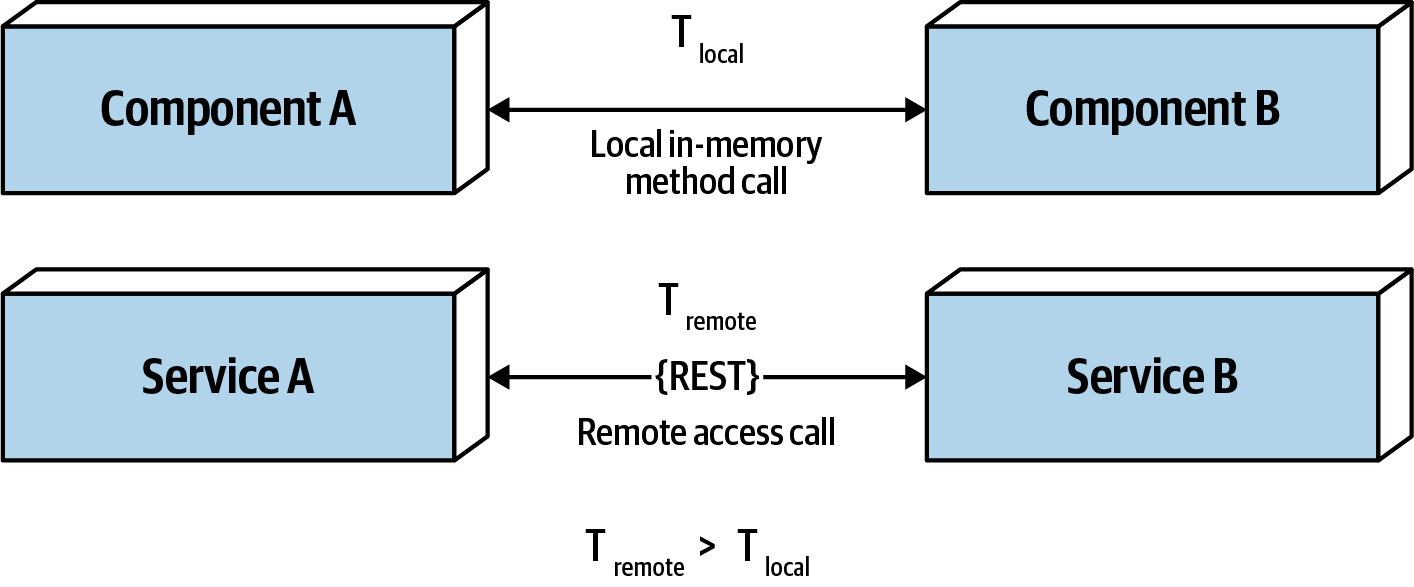One of the interesting parts from “Fundamentals of Software Architecture” book (by Neal Ford & Mark Richards):
*****
Distributed architecture styles, while being much more powerful in terms of performance, scalability, and availability than monolithic architecture styles, have significant trade-offs for this power. The first group of issues facing all distributed architectures are described in the fallacies of distributed computing, first coined by L. Peter Deutsch and other colleagues from Sun Microsystems in 1994. A fallacy is something that is believed or assumed to be true but is not. All eight of the fallacies of distributed computing apply to distributed architectures today. The following sections describe each fallacy.
Fallacy #1: The Network Is Reliable
Figure 9-2. The network is not reliable
Developers and architects alike assume that the network is reliable, but it is not. While networks have become more reliable over time, the fact of the matter is that networks still remain generally unreliable. This is significant for all distributed architectures because all distributed architecture styles rely on the network for communication to and from services, as well as between services. As illustrated in Figure 9-2, Service B may be totally healthy, but Service A cannot reach it due to a network problem; or even worse, Service A made a request to Service B to process some data and does not receive a response because of a network issue. This is why things like timeouts and circuit breakers exist between services. The more a system relies on the network (such as microservices architecture), the potentially less reliable it becomes.
Fallacy #2: Latency Is Zero
Figure 9-3. Latency is not zero
As Figure 9-3 shows, when a local call is made to another component via a method or function call, that time (t_local) is measured in nanoseconds or microseconds. However, when that same call is made through a remote access protocol (such as REST, messaging, or RPC), the time measured to access that service (t_remote) is measured in milliseconds. Therefore, t_remote will always be greater that t_local. Latency in any distributed architecture is not zero, yet most architects ignore this fallacy, insisting that they have fast networks. Ask yourself this question: do you know what the average round-trip latency is for a RESTful call in your production environment? Is it 60 milliseconds? Is it 500 milliseconds?
When using any distributed architecture, architects must know this latency average. It is the only way of determining whether a distributed architecture is feasible, particularly when considering microservices (see Chapter 17) due to the fine-grained nature of the services and the amount of communication between those services. Assuming an average of 100 milliseconds of latency per request, chaining together 10 service calls to perform a particular business function adds 1,000 milliseconds to the request! Knowing the average latency is important, but even more important is also knowing the 95th to 99th percentile. While an average latency might yield only 60 milliseconds (which is good), the 95th percentile might be 400 milliseconds! It’s usually this “long tail” latency that will kill performance in a distributed architecture. In most cases, architects can get latency values from a network administrator (see “Fallacy #6: There Is Only One Administrator”).
Fallacy #3: Bandwidth Is Infinite
Figure 9-4. Bandwidth is not infinite
Bandwidth is usually not a concern in monolithic architectures, because once processing goes into a monolith, little or no bandwidth is required to process that business request. However, as shown in Figure 9-4, once systems are broken apart into smaller deployment units (services) in a distributed architecture such as microservices, communication to and between these services significantly utilizes bandwidth, causing networks to slow down, thus impacting latency (fallacy #2) and reliability (fallacy #1).
To illustrate the importance of this fallacy, consider the two services shown in Figure 9-4. Let’s say the lefthand service manages the wish list items for the website, and the righthand service manages the customer profile. Whenever a request for a wish list comes into the lefthand service, it must make an interservice call to the righthand customer profile service to get the customer name because that data is needed in the response contract for the wish list, but the wish list service on the lefthand side doesn’t have the name. The customer profile service returns 45 attributes totaling 500 kb to the wish list service, which only needs the name (200 bytes). This is a form of coupling referred to as stamp coupling. This may not sound significant, but requests for the wish list items happen about 2,000 times a second. This means that this interservice call from the wish list service to the customer profile service happens 2,000 times a second. At 500 kb for each request, the amount of bandwidth used for that one interservice call (out of hundreds being made that second) is 1 Gb!
Stamp coupling in distributed architectures consumes significant amounts of bandwidth. If the customer profile service were to only pass back the data needed by the wish list service (in this case 200 bytes), the total bandwidth used to transmit the data is only 400 kb. Stamp coupling can be resolved in the following ways:
- Create private RESTful API endpoints
- Use field selectors in the contract
- Use GraphQL to decouple contracts
- Use value-driven contracts with consumer-driven contracts (CDCs)
- Use internal messaging endpoints
Regardless of the technique used, ensuring that the minimal amount of data is passed between services or systems in a distributed architecture is the best way to address this fallacy.
Fallacy #4: The Network Is Secure
Figure 9-5. The network is not secure
Most architects and developers get so comfortable using virtual private networks (VPNs), trusted networks, and firewalls that they tend to forget about this fallacy of distributed computing: the network is not secure. Security becomes much more challenging in a distributed architecture. As shown in Figure 9-5, each and every endpoint to each distributed deployment unit must be secured so that unknown or bad requests do not make it to that service. The surface area for threats and attacks increases by magnitudes when moving from a monolithic to a distributed architecture. Having to secure every endpoint, even when doing interservice communication, is another reason performance tends to be slower in synchronous, highly-distributed architectures such as microservices or service-based architecture.
Fallacy #5: The Topology Never Changes
Figure 9-6. The network topology always changes
This fallacy refers to the overall network topology, including all of the routers, hubs, switches, firewalls, networks, and appliances used within the overall network. Architects assume that the topology is fixed and never changes. Of course it changes. It changes all the time. What is the significance of this fallacy?
Suppose an architect comes into work on a Monday morning, and everyone is running around like crazy because services keep timing out in production. The architect works with the teams, frantically trying to figure out why this is happening. No new services were deployed over the weekend. What could it be? After several hours the architect discovers that a minor network upgrade happened at 2 a.m. that morning. This supposedly “minor” network upgrade invalidated all of the latency assumptions, triggering timeouts and circuit breakers.
Architects must be in constant communication with operations and network administrators to know what is changing and when so that they can make adjustments accordingly to reduce the type of surprise previously described. This may seem obvious and easy, but it is not. As a matter of fact, this fallacy leads directly to the next fallacy.
Fallacy #6: There Is Only One Administrator
Figure 9-7. There are many network administrators, not just one
Architects all the time fall into this fallacy, assuming they only need to collaborate and communicate with one administrator. As shown in Figure 9-7, there are dozens of network administrators in a typical large company. Who should the architect talk to with regard to latency (“Fallacy #2: Latency Is Zero”) or topology changes (“Fallacy #5: The Topology Never Changes”)? This fallacy points to the complexity of distributed architecture and the amount of coordination that must happen to get everything working correctly. Monolithic applications do not require this level of communication and collaboration due to the single deployment unit characteristics of those architecture styles.
Fallacy #7: Transport Cost Is Zero
Figure 9-8. Remote access costs money
Many software architects confuse this fallacy for latency (“Fallacy #2: Latency Is Zero”). Transport cost here does not refer to latency, but rather to actual cost in terms of money associated with making a “simple RESTful call.” Architects assume (incorrectly) that the necessary infrastructure is in place and sufficient for making a simple RESTful call or breaking apart a monolithic application. It is usually not. Distributed architectures cost significantly more than monolithic architectures, primarily due to increased needs for additional hardware, servers, gateways, firewalls, new subnets, proxies, and so on.
Whenever embarking on a distributed architecture, we encourage architects to analyze the current server and network topology with regard to capacity, bandwidth, latency, and security zones to not get caught up in the trap of surprise with this fallacy.
Fallacy #8: The Network Is Homogeneous
Figure 9-9. The network is not homogeneous
Most architects and developers assume a network is homogeneous—made up by only one network hardware vendor. Nothing could be farther from the truth. Most companies have multiple network hardware vendors in their infrastructure, if not more.
So what? The significance of this fallacy is that not all of those heterogeneous hardware vendors play together well. Most of it works, but does Juniper hardware seamlessly integrate with Cisco hardware? Networking standards have evolved over the years, making this less of an issue, but the fact remains that not all situations, load, and circumstances have been fully tested, and as such, network packets occasionally get lost. This in turn impacts network reliability (“Fallacy #1: The Network Is Reliable”), latency assumptions and assertions (“Fallacy #2: Latency Is Zero”), and assumptions made about the bandwidth (“Fallacy #3: Bandwidth Is Infinite”). In other words, this fallacy ties back into all of the other fallacies, forming an endless loop of confusion and frustration when dealing with networks (which is necessary when using distributed architectures).














